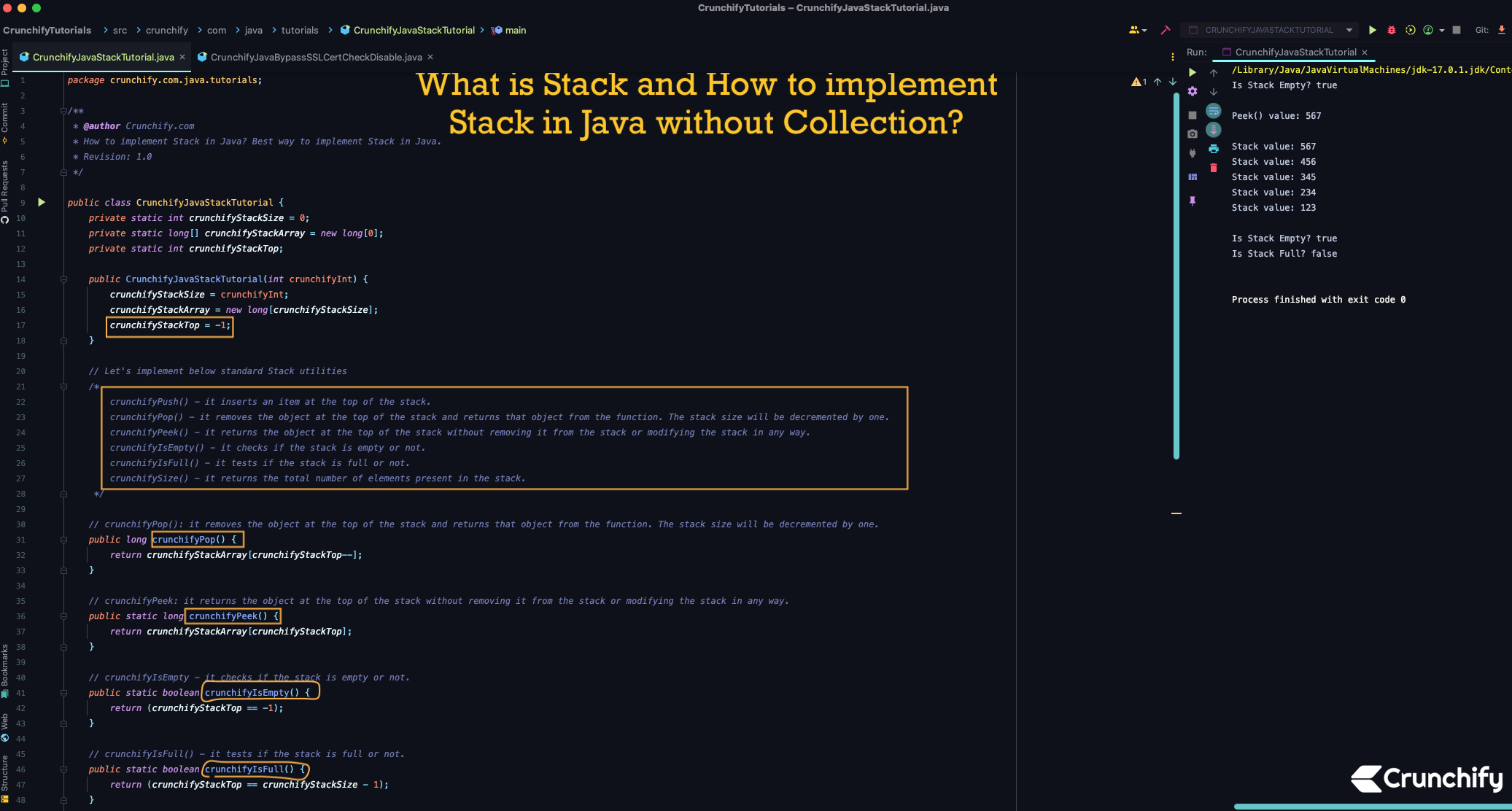Qu'est-ce que Stack et comment implémenter Stack en Java sans Collection ?
Publié: 2022-06-27
Qu'est-ce que Stack en Java ?
Avez-vous entendu parler de LIFO? Concept du dernier entré, premier sorti ? Eh bien, Stack est une implémentation LIFO de la structure de données linéaire. Cela signifie que les objets peuvent être insérés ou supprimés d'une seule extrémité OU en d'autres termes uniquement du haut.
Voici notre propre implémentation de Stack en Java
Nous allons créer ci-dessous des fonctions pour Java Stack. Veuillez noter ici : nous n'utilisons aucune classe de collection Java intégrée pour l'implémentation de Stack.
Nous utiliserons Java Collection for Stack dans le prochain tutoriel. Il est maintenant disponible Lien de l'article.
- crunchifyPush() - il insère un élément en haut de la pile.
- crunchifyPop() - il supprime l'objet en haut de la pile et renvoie cet objet de la fonction. La taille de la pile sera décrémentée de un.
- crunchifyPeek() - il renvoie l'objet en haut de la pile sans le supprimer de la pile ni modifier la pile de quelque manière que ce soit.
- crunchifyIsEmpty() - il vérifie si la pile est vide ou non.
- crunchifyIsFull() - il teste si la pile est pleine ou non.
- crunchifySize() - il renvoie le nombre total d'éléments présents dans la pile.
Commençons:
- Créer la classe CrunchifyJavaStackTutorial.java
- Copiez le code ci-dessous dans votre Eclipse ou IntelliJ IDEA.
|
1 2 3 4 5 6 7 8 9 10 11 12 13 14 15 16 17 18 19 20 21 22 23 24 25 26 27 28 29 30 31 32 33 34 35 36 37 38 39 40 41 42 43 44 45 46 47 48 49 50 51 52 53 54 55 56 57 58 59 60 61 62 63 64 65 66 67 68 69 70 71 72 73 74 75 76 77 78 79 80 81 82 83 84 85 86 87 88 |
package crunchify . com . java . tutorials ; /** * @author Crunchify.com * How to implement Stack in Java? Best way to implement Stack in Java. * Revision: 1.0 */ public class CrunchifyJavaStackTutorial { private static int crunchifyStackSize = 0 ; private static long [ ] crunchifyStackArray = new long [ 0 ] ; private static int crunchifyStackTop ; public CrunchifyJavaStackTutorial ( int crunchifyInt ) { crunchifyStackSize = crunchifyInt ; crunchifyStackArray = new long [ crunchifyStackSize ] ; crunchifyStackTop = - 1 ; } // Let's implement below standard Stack utilities /* crunchifyPush() - it inserts an item at the top of the stack. crunchifyPop() - it removes the object at the top of the stack and returns that object from the function. The stack size will be decremented by one. crunchifyPeek() - it returns the object at the top of the stack without removing it from the stack or modifying the stack in any way. crunchifyIsEmpty() - it checks if the stack is empty or not. crunchifyIsFull() - it tests if the stack is full or not. crunchifySize() - it returns the total number of elements present in the stack. */ // crunchifyPop(): it removes the object at the top of the stack and returns that object from the function. The stack size will be decremented by one. public long crunchifyPop ( ) { return crunchifyStackArray [ crunchifyStackTop -- ] ; } // crunchifyPeek: it returns the object at the top of the stack without removing it from the stack or modifying the stack in any way. public static long crunchifyPeek ( ) { return crunchifyStackArray [ crunchifyStackTop ] ; } // crunchifyIsEmpty - it checks if the stack is empty or not. public static boolean crunchifyIsEmpty ( ) { return ( crunchifyStackTop == - 1 ) ; } // crunchifyIsFull() - it tests if the stack is full or not. public static boolean crunchifyIsFull ( ) { return ( crunchifyStackTop == crunchifyStackSize - 1 ) ; } // crunchifyPush() - it inserts an item at the top of the stack. public void crunchifyPush ( long j ) { crunchifyStackArray [ ++ crunchifyStackTop ] = j ; } // crunchifySize() - it returns the total number of elements present in the stack. public static int crunchifySize ( ) { return crunchifyStackTop + 1 ; } public static void main ( String [ ] crunchifyArgs ) { CrunchifyJavaStackTutorial crunchifyStack = new CrunchifyJavaStackTutorial ( 5 ) ; crunchifyPrint ( "Is Stack Empty? " + crunchifyIsEmpty ( ) + "\n" ) ; crunchifyStack . crunchifyPush ( 123 ) ; crunchifyStack . crunchifyPush ( 234 ) ; crunchifyStack . crunchifyPush ( 345 ) ; crunchifyStack . crunchifyPush ( 456 ) ; crunchifyStack . crunchifyPush ( 567 ) ; crunchifyPrint ( "Peek() value: " + crunchifyPeek ( ) + "\n" ) ; while ( ! crunchifyIsEmpty ( ) ) { long crunchifyValue = crunchifyStack . crunchifyPop ( ) ; crunchifyPrint ( "Stack value: " + crunchifyValue ) ; } crunchifyPrint ( "" ) ; crunchifyPrint ( "Is Stack Empty? " + crunchifyIsEmpty ( ) ) ; crunchifyPrint ( "Is Stack Full? " + crunchifyIsFull ( ) + "\n" ) ; } // Simple Crunchify Print Utility private static void crunchifyPrint ( Object crunchifyValue ) { System . out . println ( crunchifyValue ) ; } } |
Exécutez le programme Java :
Exécutez simplement le programme ci-dessus en tant qu'application Java et vous devriez voir le résultat ci-dessous.

|
1 2 3 4 5 6 7 8 9 10 11 12 13 14 15 |
Is Stack Empty ? true Peek ( ) value : 567 Stack value : 567 Stack value : 456 Stack value : 345 Stack value : 234 Stack value : 123 Is Stack Empty ? true Is Stack Full ? false Process finished with exit code 0 |
Faites-moi savoir si vous avez des questions ou si vous obtenez une exception en cours d'exécution au-dessus du programme Java et je serai plus qu'heureux de déboguer cela avec vous.
